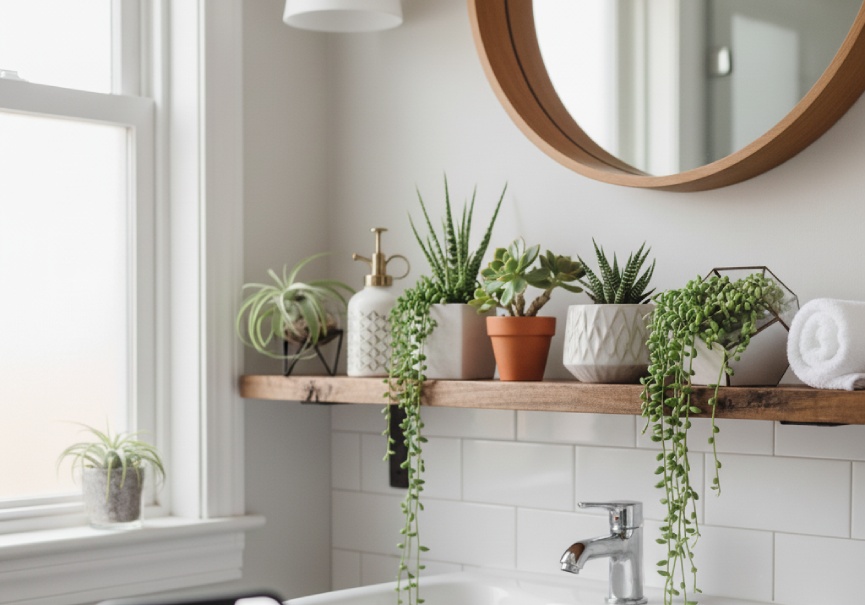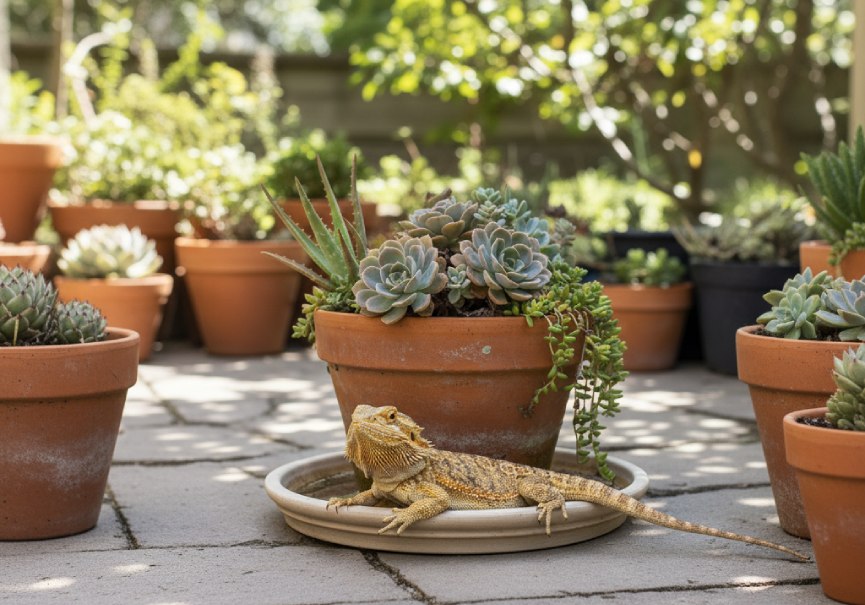Do Succulents Do Well in Bathrooms? A Comprehensive Guide to Growing Succulents in Your Bathroom

Introduction
Succulents continue to gain popularity for their sculptural beauty, drought tolerance, and low-maintenance charm. Their ability to store water in their leaves, stems, or roots makes them ideal for busy plant lovers or anyone who occasionally forgets to water. However, many plant lovers still wonder: Do succulents do well in bathrooms?
In this guide, we explore whether succulents truly thrive in bathroom environments. We break down humidity, light needs, and environmental considerations and offer practical tips to successfully grow these striking plants in your bathroom.
Do Succulents Do Well in Bathrooms?
Short answer: Yes, some succulents can do well in bathrooms, but not all. Bathrooms often have higher humidity, limited ventilation, and low lighting, which are not typical desert-like conditions most succulents prefer. However, with the right plant selection and care, many succulents can adapt and even thrive.
Understanding Bathroom Conditions
Humidity
Bathrooms naturally have higher humidity levels due to showers and baths. Excess moisture can cause rot and fungal issues in many succulents. The key is choosing humidity-tolerant varieties and ensuring proper airflow.
Temperature Fluctuations
Bathrooms experience temperature swings from hot showers to cooler periods. Hardy succulents usually tolerate this, but delicate ones may struggle.
Light Levels
Many bathrooms have limited natural light, making it essential to choose low-light tolerant succulent varieties or supplement with artificial light.
Why Choose Succulents for Bathrooms?
- They store water, so you do not need to water frequently.
- Many varieties tolerate warm, humid environments.
- They improve air quality by absorbing impurities.
- They add greenery, texture, and calm to bathroom decor.
- They require minimal maintenance compared to other houseplants.
The key is choosing plants that naturally adapt to these spaces.
Ideas for Keeping Succulents in a Bathroom
If your bathroom has minimal sunlight, try the following tips:
1. Use Artificial Lighting
Install LED grow lights to supplement natural light. Placing them near your plants ensures they receive enough brightness to photosynthesize.
2. Choose Low-Light-Tolerant Species
Good options include:
- Snake Plant (Sansevieria)
- ZZ Plant (Zamioculcas zamiifolia)
- Haworthia varieties
3. Use Reflective Surfaces
Mirrors and light-colored tiles help bounce available light to your plants.
4. Ensure Good Ventilation
Use exhaust fans or open the bathroom door to reduce excessive humidity.
5. Create Vertical Plant Displays
Try wall planters or hanging planters for small trailing succulents.
Introduction
Succulents continue to gain popularity for their sculptural beauty, drought tolerance, and low-maintenance charm. Their ability to store water in their leaves, stems, or roots makes them ideal for busy plant lovers or anyone who occasionally forgets to water. However, many plant lovers still wonder: Do succulents do well in bathrooms?
In this guide, we explore whether succulents truly thrive in bathroom environments. We break down humidity, light needs, and environmental considerations and offer practical tips to successfully grow these striking plants in your bathroom.
Do Succulents Do Well in Bathrooms?
Short answer: Yes, some succulents can do well in bathrooms, but not all. Bathrooms often have higher humidity, limited ventilation, and low lighting, which are not typical desert-like conditions most succulents prefer. However, with the right plant selection and care, many succulents can adapt and even thrive.
Understanding Bathroom Conditions
Humidity
Bathrooms naturally have higher humidity levels due to showers and baths. Excess moisture can cause rot and fungal issues in many succulents. The key is choosing humidity-tolerant varieties and ensuring proper airflow.
Temperature Fluctuations
Bathrooms experience temperature swings from hot showers to cooler periods. Hardy succulents usually tolerate this, but delicate ones may struggle.
Light Levels
Many bathrooms have limited natural light, making it essential to choose low-light-tolerant succulent varieties or supplement with artificial light.
Why Choose Succulents for Bathrooms?
- They store water, so you do not need to water frequently.
- Many varieties tolerate warm, humid environments.
- They improve air quality by absorbing impurities.
- They add greenery, texture, and calm to bathroom decor.
- They require minimal maintenance compared to other houseplants.
The key is choosing plants that naturally adapt to these spaces.
Ideas for Keeping Succulents in a Bathroom
If your bathroom has minimal sunlight, try the following tips:
1. Use Artificial Lighting
Install LED grow lights to supplement natural light. Placing them near your plants ensures they receive enough brightness to photosynthesize.
2. Choose Low-Light-Tolerant Species
Good options include:
- Snake Plant (Sansevieria)
- ZZ Plant (Zamioculcas zamiifolia)
- Haworthia varieties
3. Use Reflective Surfaces
Mirrors and light-colored tiles help bounce available light to your plants.
4. Ensure Good Ventilation
Use exhaust fans or open the bathroom door to reduce excessive humidity.
5. Create Vertical Plant Displays
Try wall planters or hanging planters for small trailing succulents.
6. Water Sparingly
Bathrooms stay humid, so reduce watering to avoid rot.
7. Try a Terrarium Setup
Terrariums help manage humidity and retain warmth, perfect for humidity-tolerant succulents.
Best Succulents for Bathrooms
Aloe Vera
Thrives in bright, indirect light and tolerates humidity well. Offers soothing medicinal gel.
Snake Plant (Sansevieria)
Excellent in low light and fluctuating humidity. Hardy and architectural.
Haworthia
Compact rosettes that prefer filtered light and moderate humidity.
ZZ Plant
Ideal for low-light spaces. Tolerates humidity and requires minimal care.
Pothos (Not a succulent but bathroom-friendly)
Excellent trailing option for low-light bathrooms.
Jade Plant
Prefers bright, indirect light and moderate humidity. Easy to care for.
Peperomia
Diverse foliage textures and colors. Handles humidity well.
String of Pearls
Prefers bright, indirect light and tolerates humidity when airflow is good.
Succulents to Avoid in Bathrooms
Avoid humidity-sensitive species such as:
- Echeveria
- Lithops (Living Stones)
- Sempervivum (Hens and Chicks)
- Agave
- Crassula Buddha’s Temple
- Sedum Adolphii
These varieties prefer dry air and can rot in bathroom conditions.
Benefits of Bathroom Succulents
Improved Air Quality
Succulents refresh the air by absorbing pollutants and releasing oxygen.
Extra Humidity
Humidity-friendly succulents thrive in bathrooms, reducing watering frequency.
Aesthetic Appeal
Succulents bring life, texture, and tranquility, enhancing bathroom decor.
Placement and Lighting Tips
- Near a frosted or curtained window with filtered light
- On shelves, window sills, or countertop corners
- Under grow lights if no natural light is available
Aim for bright, indirect light when possible.
Watering and Drainage
Water Sparingly
Let the soil dry completely before watering. Moist bathroom air slows evaporation.
Use Pots With Drainage
Avoid water-logged soil by using drainage holes and well-draining soil mixes.
Preventing Mold and Rot
- Ensure airflow with fans or open windows
- Allow soil to dry completely
- Avoid misting succulents
- Do not overcrowd potting areas
Common Challenges and Solutions
Low Light
Solution: Use grow lights or choose low-light succulents.
Fungal Issues
Solution: Improve ventilation and water less frequently.
Overwatering
Solution: Use the soak-and-dry method and fast-draining soil.
Care Tips for Bathroom Succulents
- Keep temperatures between 65°F and 85°F
- Provide indirect or supplemental light
- Use well-draining succulent soil
- Fertilize sparingly during the growing season
Conclusion
Succulents can thrive in bathrooms when you select the right species and provide them with proper care. Focus on low-light and humidity-tolerant varieties, maintain good airflow, and avoid overwatering. With thoughtful placement and attention, succulents add beauty and serenity to your bathroom while thriving in the unique environment.
FAQs
1. Is it okay to keep succulents in the bathroom? Ans:- Yes, if you choose humidity-tolerant varieties and ensure good airflow.
2. What lighting do bathroom succulents need? Ans:- Bright, indirect light or artificial grow lights.
3. How often should bathroom succulents be watered? Ans:- Only when the soil is arid.
4. Will a humidifier harm succulents? Ans:- High humidity can cause rot. Balance moisture carefully.
5. Which plants are alternatives to succulents in bathrooms? Ans:- Ferns, orchids, and peace lilies do well in high humidity.
6. Can all succulents survive in bathrooms? Ans:- No. Only humidity-tolerant types thrive.
7. What if my succulent stretches? Ans:- Move to brighter light or add grow lights.
8. Do succulents need direct sunlight? Ans:- They prefer indirect light. Direct sunlight can burn them.
9. Can I place succulents on a bathroom window sill? Ans:- Yes, as long as it receives good light and avoids temperature extremes.
10. How do I prevent mold? Ans:- Increase airflow, avoid overwatering, and keep soil dry.
11. Can succulents be propagated in bathrooms? Ans:- Yes, humidity helps rooting when light is adequate.
12. Do succulents purify bathroom air? Ans:- They help a little but use them mainly for decor and ambiance.
13. Can succulents live in a bathroom with no windows? Ans:- Not without grow lights. Succulents need light to survive.






